|
Theresienstadt, the "Model" ghetto
|
During the war, small
bits of information about the extreme and horrific episodes
perpetrated under the Third Reich reached an unbelieving world.
The Nazis needed to answer the world's growing concern and
yet
they wanted to continue implementing their "solution"
to the Jewish Question.
The Nazis decided to use Theresienstadt to solve the growing
outside pressure.
Through deceit and subterfuge, the Nazis transformed Theresienstadt
into a "model ghetto."
|
By 1941, conditions for Czech Jews were growing
worse. The Nazis were in the process of creating a plan of how to
treat and how to deal with Czechs and Czech-Jews. The Czech-Jewish
community had already felt pangs of loss and disunion since several
transports had already been sent East. Jakob Edelstein, a prominent
member of the Czech-Jewish community, believed that it would be
better for his community for them to be concentrated locally rather
than sent to the East.
At the same time, the Nazis were facing two dilemmas.
The first dilemma was what to do with the prominent Jews that were
being carefully watched and looked after by Aryans. Since most Jews
were sent on transports under the pretension of "work," the second
dilemma was how could the Nazis peacefully transport the elderly
Jewish generation.
Though Edelstein had hoped that the ghetto would
be located in a section of Prague, the Nazis chose the garrison
town of Terezin.
Terezin is located approximately ninety miles north
of Prague and just south of Litomerice. The town was originally
built in 1780 by Emperor Joseph II of Austria and named after his
mother, Empress Maria Theresa. Terezin consisted of the Big Fortress
and the Small Fortress. The Big Fortress was surrounded by ramparts
and contained barracks. After 1882, Terezin was no longer used as
a fortress. For the next several decades, the garrison town of Terezin
remained virtually the same, almost entirely separated from the
rest of the countryside. The Small Fortress was used as a prison
for dangerous criminals.
Terezin changed dramatically when the Nazis renamed
it Theresienstadt and sent the first Jewish transports there in
November 1941.

The Nazis sent approximately 1300 Jewish men on
two transports to Theresienstadt on November 24 and December 4,
1941. These workers made up the Aufbaukommando (construction detail),
later known in the camp as AK1 and AK2. These men were sent to transform
the garrison town. The largest and most serious problem they faced
was metamorphosing a town which in 1940 held approximately 7,000
residents into a concentration camp which needed to hold about 35,000
to 60,000. Besides the lack of housing, bathrooms were scarce, water
was severely limited and contaminated, and the town lacked sufficient
electricity.
To solve these problems, to enact German orders,
as well as coordinate the day to day affairs of the ghetto, the
Nazis appointed Jakob Edelstein as the Judenälteste (Elder
of the Jews) and a Judenrat (Jewish Council) was established.
As the Jews worked to transform Theresienstadt,
the population of Theresienstadt watched on. Though a few residents
attempted to give the Jews assistance in small ways, their mere
presence increased the restrictions on Jews' mobility. There would
soon come a day when the Theresienstadt residents would be evacuated
and the Jews would be isolated and completely dependent on the Germans.
Ghetto Theresienstadt has long been remembered
for its culture, its famous prisoners, and its visit by Red Cross
officials. What many don't know is that within this serene facade
lay a real concentration camp. With nearly sixty thousand Jews inhabiting
an area originally designed for only seven thousand - extremely
close quarters, disease, and lack of food were serious concerns.
But in many ways, life - and death - within Theresienstadt became
focused on the frequent transports to Auschwitz.

When arriving at Theresienstadt there was a great
mixture of how much people knew about their new home. Some, like
Norbert Troller, had enough information in advance to know to hide
items and valuables.1 Others, especially the elderly, were duped
by the Nazis to believe that they were going to a resort or spa.
Many elderly actually paid large sums of money for a nice location
within their new home. When they arrived, they were housed in the
same small spaces, if not smaller, as everyone else.
To get to Theresienstadt, thousands of Jews, from
orthodox to assimilated, were deported from their old homes. At
first, many of the deportees were Czech, but later many German,
Austrian, and Dutch Jews arrived. These Jews were crammed in cattle
cars with little or no water, food, or sanitation. The trains unloaded
at Bohusovice, the nearest train station to Theresienstadt, approximately
2 km away. The deportees were then forced to disembark and march
the rest of the way to Theresienstadt - carrying all of their luggage.
Once the deportees reached Theresienstadt, they
went to the checking point (called "floodgate" or "Schleuse" in
camp slang). The deportees then had their personal information written
down and placed in an index. Then, they were searched. Most especially,
the Nazis or Czech gendarmes were looking for jewelry, money, cigarettes,
as well as other items not allowed in the camp such as hot plates
and cosmetics.2 During this initial process, the deportees were
assigned to their "housing."

One of the many problems with pouring thousands
of human beings into a small space has to do with housing. Where
were 60,000 people going to sleep in a town meant to hold 7,000?
This was a problem that the Ghetto administration was constantly
trying to find solutions for. Triple-tiered bunk beds were made
and every available floor space was used. In August 1942 (camp population
not yet at its highest point), the allotted space per person was
two square yards - this included per person usage/need for lavatory,
kitchen, and storage space.3
The living/sleeping areas were covered with vermin.
These pests included, but certainly were not limited to, rats, fleas,
flies, and lice. Norbert Troller wrote about his experiences "Coming
back from such surveys [of the housing], our calves were bitten
and full of fleas that we could only remove with kerosene."4
The housing was separated by sex. Women and children
under twelve were separated from the men and the boys over age twelve.
Food was also a problem. In the beginning there
weren't even enough cauldrons to cook food for all of the inhabitants.5
In May 1942, rationing with differential treatment to different
segments of society was established. Ghetto inhabitants who worked
at hard labor received the most food while the elderly received
the least. The food scarcity affected the elderly the most. Lack
of nourishment, lack of medicines, and general susceptibility to
illness made their fatality rate extremely high.
Initially, those who had died were wrapped in a
sheet and buried. But the lack of food, lack of medicines, and lack
of space soon took its toll on Theresienstadt's population and corpses
began to outgrow the possible locations for graves.
In September 1942, a crematorium was built. There
were no gas chambers built with this crematorium, it was built to
dispose of the growing number of corpses. The crematorium could
dispose of 190 corpses per day.6 Once the ashes were searched for
melted gold (from teeth), the ashes were placed in a cardboard box
and stored. Near the end of the war, the Nazis tried to cover their
tracks by disposing of the ashes. They disposed of the ashes by
dumping 8,000 cardboard boxes into a pit and dumping 17,000 boxes
into the Ohre River.7
Though the mortality rate in the camp was high,
the largest fear lay in the transports.

Within the original transports into Theresienstadt,
many had hoped that living in Theresienstadt would preclude them
from being sent East and that their stay would last the duration
of the war.
On January 5, 1942 (less than two months since
the arrival of the first transports in), their hopes were shattered
- Daily Order No. 20 announced the first transport out of Theresienstadt.
Transports left Theresienstadt frequently and each
one was made up of one thousand to five thousand Theresienstadt
prisoners. The Nazis decided how many people were to be on each
transport but they decided to place the burden of who was to go,
on the Jews themselves. The Council of Elders became responsible
for fulfilling the Nazis' quotas.
Life or death became reliant on exclusion from
the transports East - or "protection." Automatically, all members
of the AK1 and AK2 were exempted from transports and five members
of their closest family. Other major ways to become protected were
those working in jobs that helped the German war effort, important
workers in the Ghetto administration, or being on someone else's
list.
Finding ways to keep yourself and your family on
a protection list, thus off the transports, became a major endeavor
of each Ghetto inhabitant.
Though some inhabitants were able to find protection,
nearly one-half to two-thirds of the population were not protected.8
For every transport, the bulk of the Ghetto population feared that
their name would be chosen.

On October 5, 1943, the first Danish Jews were
transported into Theresienstadt. Soon after their arrival, the Danish
Red Cross and the Swedish Red Cross began inquiring about their
whereabouts and their condition. The Nazis decided to let them visit
one location that would prove to the Danes and to the world that
Jews were living under humane conditions. But how could they change
an overcrowded, pest infected, ill-nourished, and high mortality-rate
camp into a spectacle for the world?
In December 1943, the Nazis told the Council of
Elders of Theresienstadt about the Embellishment. The commander
of Theresienstadt, SS Colonel Karl Rahm, took control of planning.
An exact route was planned for the visitors to take. All buildings
and grounds along this route were to be enhanced by green turf,
flowers, and benches. A playground, sports fields, and even a monument
were added. Prominent and Dutch Jews had their billets enlarged,
as well as had furniture, drapes, and flower boxes added.
But even with the physical transformation of the
Ghetto, Rahm thought that the Ghetto was too crowded. On May 12,
1944, Rahm ordered the deportation of 7,500 inhabitants. In this
transport, the Nazis decided that all orphans and most of the sick
should be included to help the facade that the Embellishment was
creating.
The Nazis, so clever at creating facades, didn't
miss a detail. They erected a sign over a building that read "Boys'
School" as well as another sign that read "closed during holidays."9
Needless to say, no one ever attended the school.
On the day that the commission arrived, June 23,
1944, the Nazis were fully prepared. As the tour commenced, well-rehearsed
actions took place that were created specially for the visit. Bakers
baking bread, a load of fresh vegetables being delivered, and workers
singing were all queued by messengers who ran ahead of the entourage.
After the visit, the Nazis were so impressed with
their propaganda feat that they decided to make a film.

Once the Embellishment was over, the residents
of Theresienstadt knew there would be further deportations.11 On
September 23, 1944, the Nazis ordered a transport of 5,000 able-bodied
men.
The Nazis had decided to liquidate the Ghetto and
initially chose able-bodied men to be on the first transport because
they were the most likely to rebel. Soon after the 5,000 were deported,
another order came for 1,000 more. The Nazis were able to manipulate
some of the remaining Jews by offering some of those who had just
sent family members an opportunity to join them by volunteering
for the next transport.
After these, transports continued to leave Theresienstadt
frequently. All exemptions and "protection" were abolished; the
Nazis now chose who was to go on each transport. Deportations continued
through October. After these transports, only 400 able-bodied men,
plus women, children, and elderly were left within the Ghetto.12
What was going to happen to these remaining inhabitants?
The Nazis couldn't come to an agreement. Some hoped that they could
still cover the inhumane conditions that the Jews has suffered through
and thus soften their punishment after the war. Other Nazis realized
that there would be no clemency and wanted to dispose of all the
incriminating evidence, including the remaining Jews. No real decision
was made and in some ways, both were implemented.
In the course of trying to look good, the Nazis
made a few deals with Switzerland. Even a transport of Theresienstadt
inhabitants were sent there. In April 1945, transports and death
marches reached Theresienstadt. Several of these prisoners had left
Theresienstadt just months before.
These groups were being evacuated from concentration
camps such as Auschwitz and Ravensbrück and other camps farther
East. As the Red Army pushed the Nazis farther back, they evacuated
the camps. Some of these prisoners arrived on transports while many
others arrived on foot. They were in terrible ill-health and some
carried typhus. Theresienstadt was unprepared for the large numbers
that entered and were unable to properly quarantine those with contagious
diseases; thus, a typhus epidemic broke out within Theresienstadt.
Besides typhus, these prisoners brought the truth
about the transports East. No longer could Theresienstadt inhabitants
hope that the East was not as terrible as the rumors suggested -
instead, it was much worse.
On May 3, 1945, the Ghetto Theresienstadt was placed
under the protection of the International Red Cross.
1.
Norbert Troller, Thersienstadt: Hitler's Gift to the Jews (Chapel
Hill, 1991) 4-6.
2. Zdenek Lederer, Ghetto Theresienstadt (New York,
1983) 37-38.
3. Lederer, 45.
4. Troller, 31.
5. Lederer, 47.
6. Lederer, 49.
7. Lederer, 157-158.
8. Lederer, 28.
9. Lederer, 115.
10. Lederer, 118.
11. Lederer, 146.
12. Lederer, 167

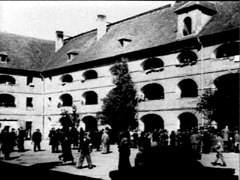
THERESIENSTADT
A ghetto in Czechoslovakia, run by the SS.
Jews were transferred from there to extermination camps.
It was used to camouflage the extermination of European
Jews,
by the Nazis who touted it as a "model Jewish settlement."
When Red Cross visited, dummy stores, cafes, schools and
gardens were set up.
|
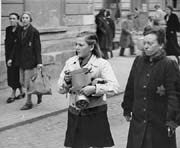
|
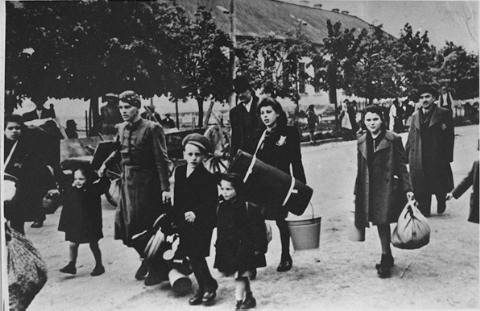
Arrival of Jews into
the Theresienstadt Ghetto
Photograph from the Lydia Chagoll Collection
|
|
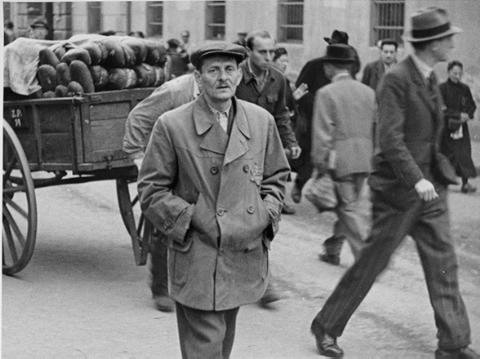
A transport of Dutch
Jews arrives in Theresienstadt.
Close-up of a man wearing a yellow star walking down a ghetto
street.
Behind him a man pulls a wagon of bread. (February 1944)
Photograph from the Ivan Vojtech Fric Collection
|
|
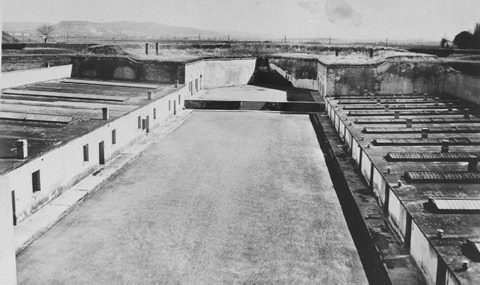
A view of the barracks
and the crematorium in Theresienstadt concentration camp.
(After May 1945)
Photograph from the Miriam Patipa Collection
|
Courtesy
of USHMM Photo Archives
|